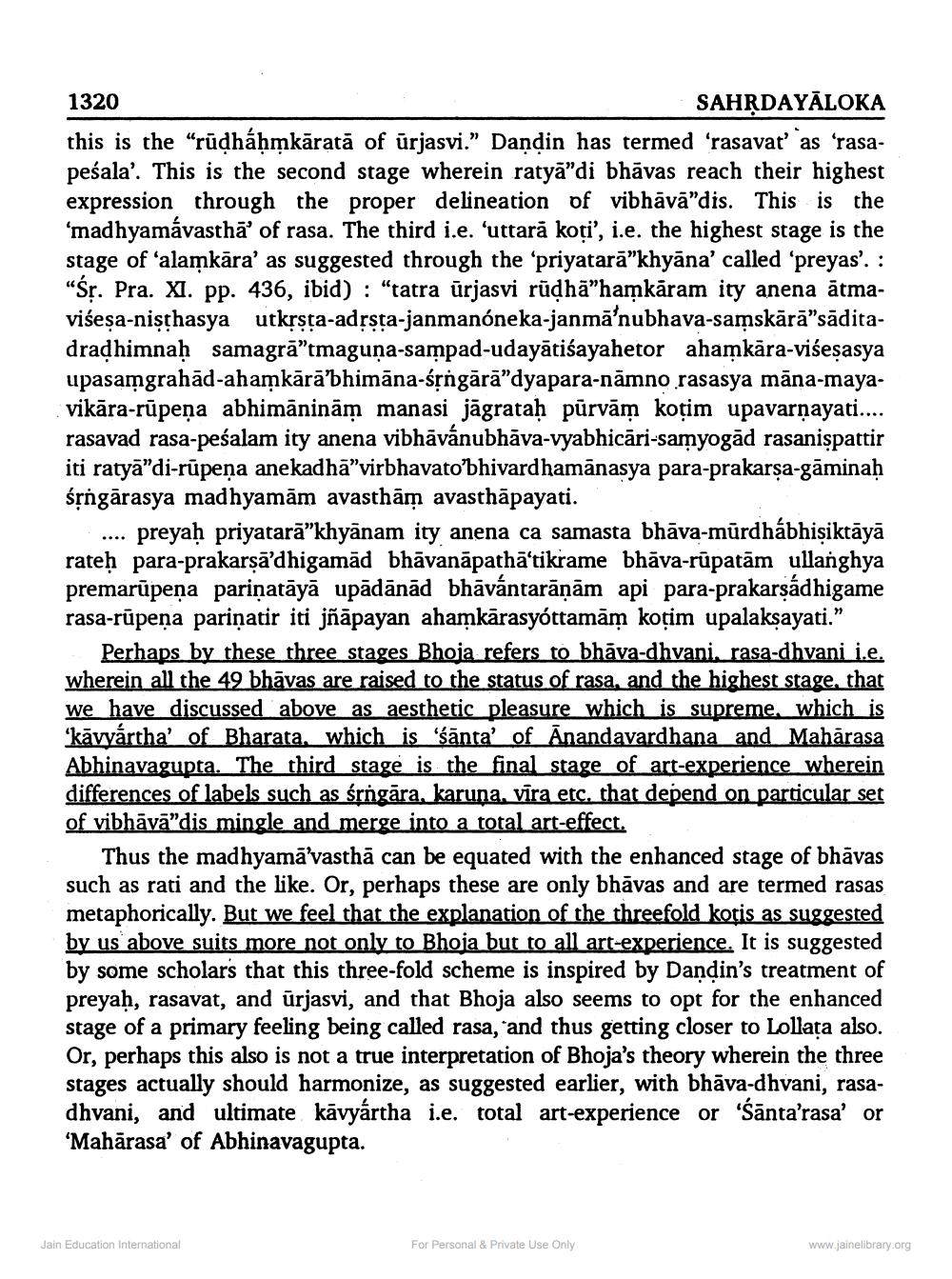________________
1320
SAHRDAYĀLOKA this is the "rūdháhmkārată of ūrjasvi.” Dandin has termed 'rasavat' as 'rasapeśala'. This is the second stage wherein ratyā"di bhāvas reach their highest expression through the proper delineation of vibhāvā"dis. This is the 'madhyamávasthā' of rasa. The third i.e. ‘uttarā koți', i.e. the highest stage is the stage of 'alamkāra' as suggested through the 'priyatarā"khyāna' called 'preyas'. : "Śr. Pra. XI. pp. 436, ibid) : "tatra ūrjasvi rūdhā”hamkāram ity anena ātmaviseșa-nişthasya utkrsta-adrsta-janmanóneka-janmā’nubhava-samskārā"sāditadraļhimnaḥ samagrā”tmaguņa-sampad-udayātiśayahetor ahamkāra-višeşasya upasamgrahād-ahamkārā'bhimāna-śộngārā”dyapara-nāmno rasasya māna-mayavikāra-rūpeṇa abhimāninām manasi jāgrataḥ pūrvām koțim upavarņayati.... rasavad rasa-peśalam ity anena vibhāvánubhāva-vyabhicāri-samyogād rasanispattir iti ratyā"di-rūpeṇa anekadhā”virbhavato bhivardhamānasya para-prakarsa-gāminaḥ śrngārasya madhyamām avasthām avasthāpayati.
... preyaḥ priyatarā”khyānam iry anena ca samasta bhāva-mūrdhábhișiktāyā rateh para-prakarsā’dhigamād bhāvanāpathāʻtikrame bhāva-rūpatām ullanghya premarūpena parinatāyā upādānād bhāvántarāņām api para-prakarsadhigame rasa-rūpena pariņatir iti jñāpayan ahamkārasyóttamām koțim upalaksayati.”
Perhaps by these three stages Bhoja refers to bhāva-dhvani, rasa-dhvani i.e. wherein all the 49 bhāvas are raised to the status of rasa, and the highest stage, that we have discussed above as aesthetic pleasure which is supreme, which is ‘kāvyártha' of Bharata, which is 'śānta' of Anandavardhana and Mahārasa Abhinavagupta. The third stage is the final stage of art-experience wherein differences of labels such as śrngāra, karuna, vīra etc. that depend on particular set of vibhāvā"dis mingle and merge into a total art-effect.
Thus the madhyamā'vasthā can be equated with the enhanced stage of bhāvas such as rati and the like. Or, perhaps these are only bhāvas and are termed rasas metaphorically. But we feel that the explanation of the threefold kotis as suggested by us above suits more not only to Bhoja but to all art-experience. It is suggested by some scholars that this three-fold scheme is inspired by Dandin's treatment of preyaḥ, rasavat, and ūrjasvi, and that Bhoja also seems to opt for the enhanced stage of a primary feeling being called rasa, and thus getting closer to Lollata also. Or, perhaps this also is not a true interpretation of Bhoja's theory wherein the three stages actually should harmonize, as suggested earlier, with bhāva-dhvani, rasadhvani, and ultimate kāvyártha i.e. total art-experience or 'Sānta'rasa' or 'Mahārasa' of Abhinavagupta.
Jain Education International
For Personal & Private Use Only
www.jainelibrary.org




